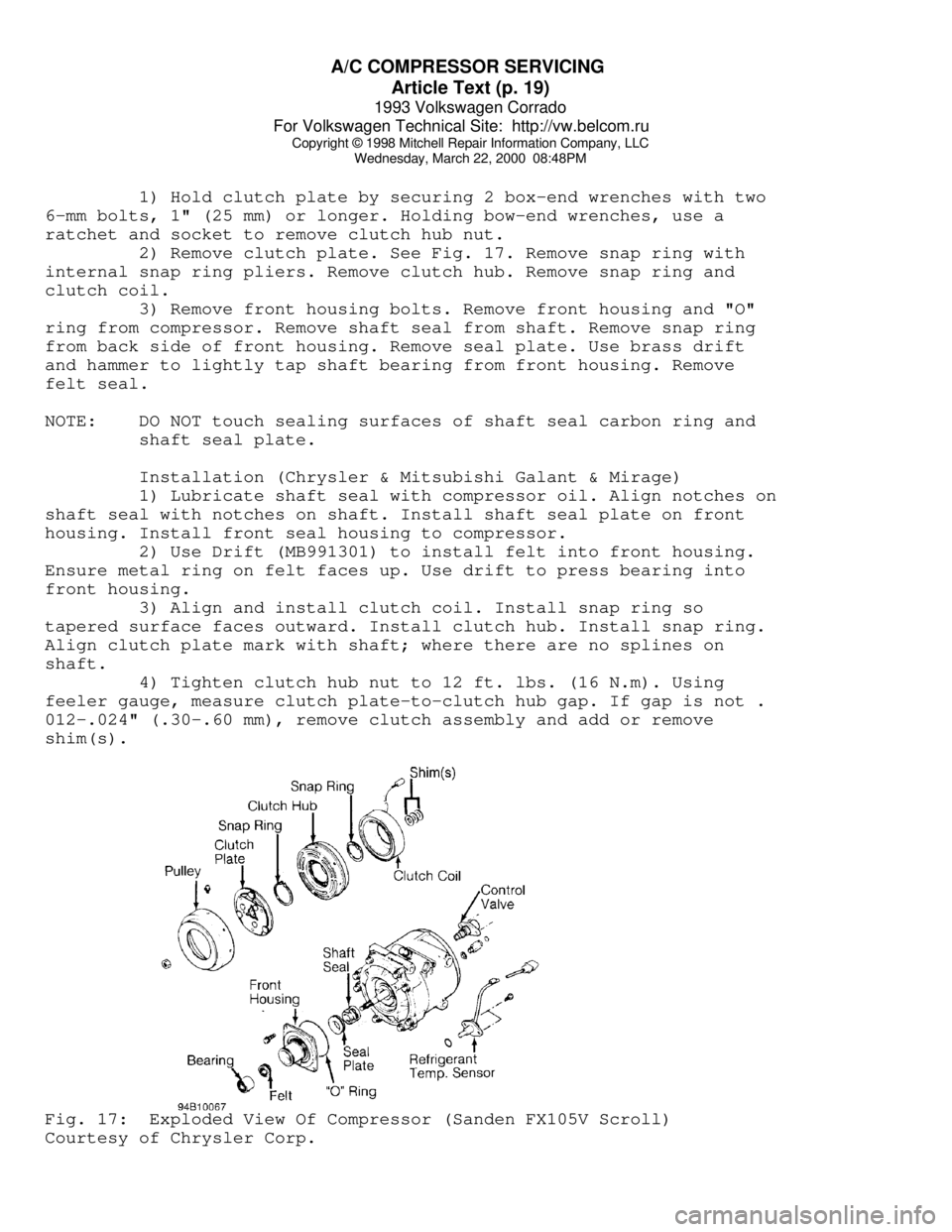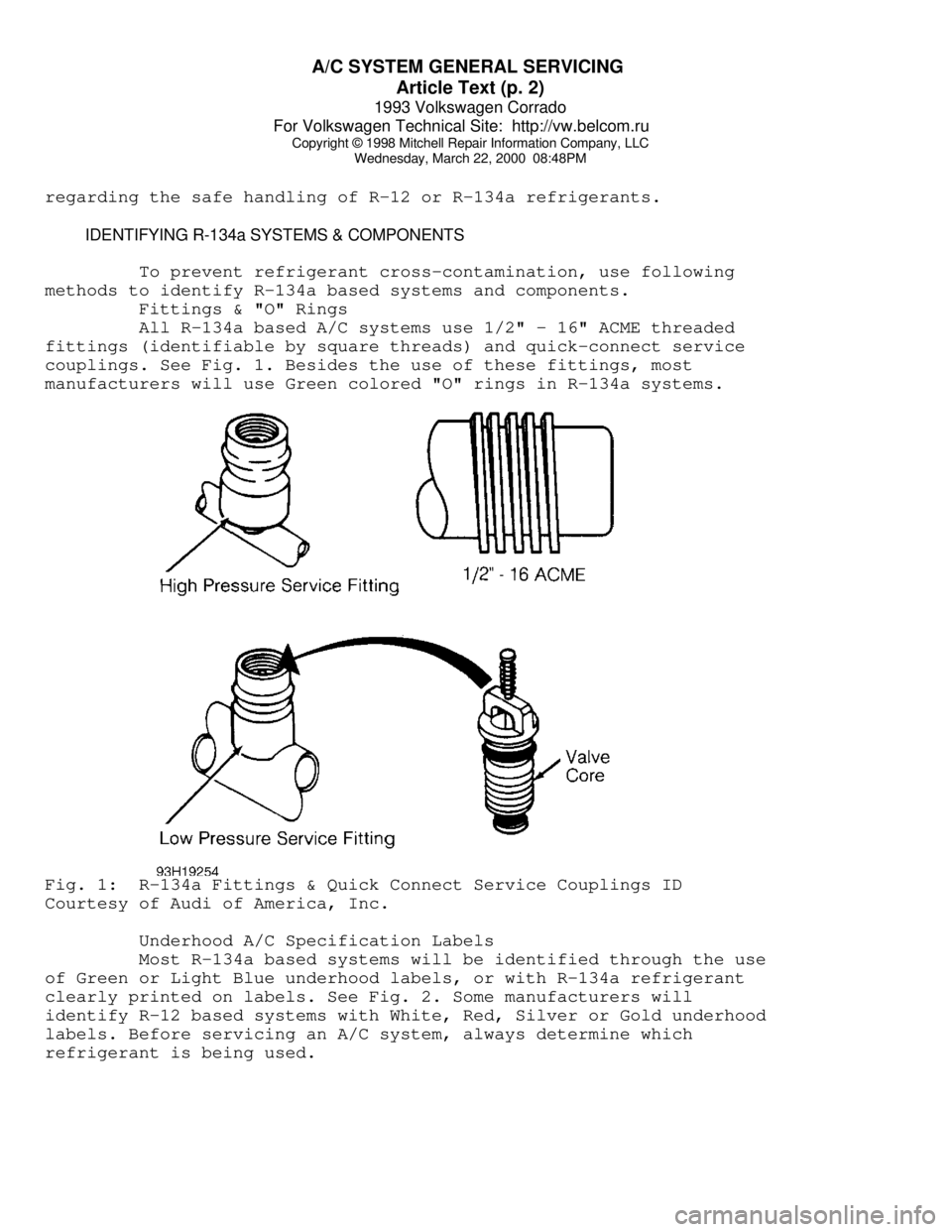1993 VOLKSWAGEN CORRADO light
[x] Cancel search: lightPage 355 of 920

A/C COMPRESSOR SERVICING
Article Text (p. 19)
1993 Volkswagen Corrado
For Volkswagen Technical Site: http://vw.belcom.ru
Copyright © 1998 Mitchell Repair Information Company, LLC
Wednesday, March 22, 2000 08:48PM
1) Hold clutch plate by securing 2 box-end wrenches with two
6-mm bolts, 1" (25 mm) or longer. Holding bow-end wrenches, use a
ratchet and socket to remove clutch hub nut.
2) Remove clutch plate. See Fig. 17. Remove snap ring with
internal snap ring pliers. Remove clutch hub. Remove snap ring and
clutch coil.
3) Remove front housing bolts. Remove front housing and "O"
ring from compressor. Remove shaft seal from shaft. Remove snap ring
from back side of front housing. Remove seal plate. Use brass drift
and hammer to lightly tap shaft bearing from front housing. Remove
felt seal.
NOTE: DO NOT touch sealing surfaces of shaft seal carbon ring and
shaft seal plate.
Installation (Chrysler & Mitsubishi Galant & Mirage)
1) Lubricate shaft seal with compressor oil. Align notches on
shaft seal with notches on shaft. Install shaft seal plate on front
housing. Install front seal housing to compressor.
2) Use Drift (MB991301) to install felt into front housing.
Ensure metal ring on felt faces up. Use drift to press bearing into
front housing.
3) Align and install clutch coil. Install snap ring so
tapered surface faces outward. Install clutch hub. Install snap ring.
Align clutch plate mark with shaft; where there are no splines on
shaft.
4) Tighten clutch hub nut to 12 ft. lbs. (16 N.m). Using
feeler gauge, measure clutch plate-to-clutch hub gap. If gap is not .
012-.024" (.30-.60 mm), remove clutch assembly and add or remove
shim(s).Fig. 17: Exploded View Of Compressor (Sanden FX105V Scroll)
Courtesy of Chrysler Corp.
Page 366 of 920

A/C SYSTEM GENERAL DIAGNOSTIC PROCEDURES
Article Text (p. 4)
1993 Volkswagen Corrado
For Volkswagen Technical Site: http://vw.belcom.ru
Copyright © 1998 Mitchell Repair Information Company, LLC
Wednesday, March 22, 2000 08:48PMÚÄÄÄÄÄÄÄÄÂÄÄÄÄÄÄÄÄÄÂÄÄÄÄÄÄÄÄÄÄÄÄÄÄÄÄÄÄÄÄÄÄÄÄÄÄÄÄÄÂÄÄÄÄÄÄÄÄÄÄÄÄÄÄÄÄÄÄÄ¿
³Low Side
³High Side³ Other Symptoms (1) ³ Diagnosis ³
³ Gauge
³ Gauge ³ ³ ³
ÃÄÄÄÄÄÄÄÄÅÄÄÄÄÄÄÄÄÄÅÄÄÄÄÄÄÄÄÄÄÄÄÄÄÄÄÄÄÄÄÄÄÄÄÄÄÄÄÄÅÄÄÄÄÄÄÄÄÄÄÄÄÄÄÄÄÄÄÄ´
³ NORMAL
³ NORMAL ³ No or few bubbles in sight ³Some Air & Moisture³
³
³ ³ glass. High side gauge may ³in System ³
³
³ ³ go high. Low side gauge ³ ³
³
³ ³ does not fluctuate with ³ ³
³
³ ³ compressor on/off cycle. ³ ³
ÃÄÄÄÄÄÄÄÄÅÄÄÄÄÄÄÄÄÄÅÄÄÄÄÄÄÄÄÄÄÄÄÄÄÄÄÄÄÄÄÄÄÄÄÄÄÄÄÄÅÄÄÄÄÄÄÄÄÄÄÄÄÄÄÄÄÄÄÄ´
³ NORMAL
³ NORMAL ³ Cools okay in morning but ³ Excessive Moisture³
³
³ ³ not during hot part of day. ³ in System ³
³
³ ³ Bubbles in sight glass. ³ ³
³
³ ³ Discharge air warm when low ³ ³
³
³ ³ side gauge drops into ³ ³
³
³ ³ vacuum. ³ ³
ÃÄÄÄÄÄÄÄÄÅÄÄÄÄÄÄÄÄÄÅÄÄÄÄÄÄÄÄÄÄÄÄÄÄÄÄÄÄÄÄÄÄÄÄÄÄÄÄÄÅÄÄÄÄÄÄÄÄÄÄÄÄÄÄÄÄÄÄÄ´
³ NORMAL
³ NORMAL ³ Thermostatic sw. sys. only- ³ Defective ³
³
³ ³ compressor cycles off & on ³ Thermostatic Sw. ³
³
³ ³ too rapidly. ³ ³
ÃÄÄÄÄÄÄÄÄÅÄÄÄÄÄÄÄÄÄÅÄÄÄÄÄÄÄÄÄÄÄÄÄÄÄÄÄÄÄÄÄÄÄÄÄÄÄÄÄÅÄÄÄÄÄÄÄÄÄÄÄÄÄÄÄÄÄÄÄ´
³ NORMAL
³ NORMAL ³ Cycling clutch sys only - ³Misadjusted ³
³ to
³ ³ compressor doesn't turn on ³Thermostatic Sw. or³
³ HIGH
³ ³ soon enough. ³Defective Pressure ³
³
³ ³ Discharge air becomes warm ³Sensing Switch ³
³
³ ³ as low side pressure rises. ³ ³
ÃÄÄÄÄÄÄÄÄÅÄÄÄÄÄÄÄÄÄÅÄÄÄÄÄÄÄÄÄÄÄÄÄÄÄÄÄÄÄÄÄÄÄÄÄÄÄÄÄÅÄÄÄÄÄÄÄÄÄÄÄÄÄÄÄÄÄÄÄ´
³ LOW
³ LOW ³ Bubbles in sight glass. ³ Low R-12 Charge ³
³
³ ³ Outlet air slightly cool. ³ ³
ÃÄÄÄÄÄÄÄÄÅÄÄÄÄÄÄÄÄÄÅÄÄÄÄÄÄÄÄÄÄÄÄÄÄÄÄÄÄÄÄÄÄÄÄÄÄÄÄÄÅÄÄÄÄÄÄÄÄÄÄÄÄÄÄÄÄÄÄÄ´
³ LOW
³ LOW ³ Sight glass clear. ³ Excessively Low ³
³
³ ³ Outlet air very warm. ³ R-12 Charge ³
ÃÄÄÄÄÄÄÄÄÅÄÄÄÄÄÄÄÄÄÅÄÄÄÄÄÄÄÄÄÄÄÄÄÄÄÄÄÄÄÄÄÄÄÄÄÄÄÄÄÅÄÄÄÄÄÄÄÄÄÄÄÄÄÄÄÄÄÄÄ´
³ LOW
³ LOW ³ Outlet air slightly cool. ³ Expansion Valve ³
³
³ ³ Sweating or frost at ³Stuck Closed Screen³
³
³ ³ expansion valve. ³ Plugged or Sensing³
³
³ ³ ³ Bulb Malfunction ³
ÃÄÄÄÄÄÄÄÄÅÄÄÄÄÄÄÄÄÄÅÄÄÄÄÄÄÄÄÄÄÄÄÄÄÄÄÄÄÄÄÄÄÄÄÄÄÄÄÄÅÄÄÄÄÄÄÄÄÄÄÄÄÄÄÄÄÄÄÄ´
³ LOW
³ LOW ³ Outlet air slightly cool. ³ Restriction on ³
³
³ ³High side line cool to touch.³ High Side ³
³
³ ³ Sweating or frost on ³ ³
³
³ ³ high side. ³ ³
ÃÄÄÄÄÄÄÄÄÅÄÄÄÄÄÄÄÄÄÅÄÄÄÄÄÄÄÄÄÄÄÄÄÄÄÄÄÄÄÄÄÄÄÄÄÄÄÄÄÅÄÄÄÄÄÄÄÄÄÄÄÄÄÄÄÄÄÄÄ´
³ LOW
³ HIGH ³ Evaporator outlet pipe cold.³ STV Stuck Open ³
³
³ ³ Low side goes into vacuum ³ ³
³
³ ³ when blower is disconnected.³ ³
ÃÄÄÄÄÄÄÄÄÅÄÄÄÄÄÄÄÄÄÅÄÄÄÄÄÄÄÄÄÄÄÄÄÄÄÄÄÄÄÄÄÄÄÄÄÄÄÄÄÅÄÄÄÄÄÄÄÄÄÄÄÄÄÄÄÄÄÄÄ´
³ HIGH
³ LOW ³ Evaporator outlet pipe warm.³ STV Stuck Closed ³
³
³ ³ Outlet air warm. ³ ³
ÃÄÄÄÄÄÄÄÄÅÄÄÄÄÄÄÄÄÄÅÄÄÄÄÄÄÄÄÄÄÄÄÄÄÄÄÄÄÄÄÄÄÄÄÄÄÄÄÄÅÄÄÄÄÄÄÄÄÄÄÄÄÄÄÄÄÄÄÄ´
³ HIGH
³ LOW ³ Noise from compressor. ³ Compressor ³
³
³ ³ ³ Malfunction ³
Page 367 of 920

A/C SYSTEM GENERAL DIAGNOSTIC PROCEDURES
Article Text (p. 5)
1993 Volkswagen Corrado
For Volkswagen Technical Site: http://vw.belcom.ru
Copyright © 1998 Mitchell Repair Information Company, LLC
Wednesday, March 22, 2000 08:48PMÃÄÄÄÄÄÄÄÄÅÄÄÄÄÄÄÄÄÄÅÄÄÄÄÄÄÄÄÄÄÄÄÄÄÄÄÄÄÄÄÄÄÄÄÄÄÄÄÄÅÄÄÄÄÄÄÄÄÄÄÄÄÄÄÄÄÄÄÄ´
³ HIGH
³ HIGH ³ Outlet air warm. ³ Compressor ³
³
³ ³ Liquid line very hot. ³ Malfunction ³
³
³ ³ Bubbles in sight glass. ³ or ³
³
³ ³ ³ R-12 Overcharge ³
ÃÄÄÄÄÄÄÄÄÅÄÄÄÄÄÄÄÄÄÅÄÄÄÄÄÄÄÄÄÄÄÄÄÄÄÄÄÄÄÄÄÄÄÄÄÄÄÄÄÅÄÄÄÄÄÄÄÄÄÄÄÄÄÄÄÄÄÄÄ´
³ HIGH
³ HIGH ³ Outlet air slightly cool. ³Large Amount of Air³
³
³ ³ Bubbles in sight glass. ³ of Air & Moisture ³
³
³ ³ ³ in System ³
ÃÄÄÄÄÄÄÄÄÅÄÄÄÄÄÄÄÄÄÅÄÄÄÄÄÄÄÄÄÄÄÄÄÄÄÄÄÄÄÄÄÄÄÄÄÄÄÄÄÅÄÄÄÄÄÄÄÄÄÄÄÄÄÄÄÄÄÄÄ´
³ HIGH
³ HIGH ³ Outlet air warm. ³ Expansion Valve ³
³
³ ³ Evaporator outlet sweating ³ Stuck Open ³
³
³ ³ and frost. ³ ³
ÃÄÄÄÄÄÄÄÄÁÄÄÄÄÄÄÄÄÄÁÄÄÄÄÄÄÄÄÄÄÄÄÄÄÄÄÄÄÄÄÄÄÄÄÄÄÄÄÄÁÄÄÄÄÄÄÄÄÄÄÄÄÄÄÄÄÄÄÄ´
³(1) - If equipped with a low refrigerant charge protection system,
³
³ compressor operation may have stopped.
³
ÀÄÄÄÄÄÄÄÄÄÄÄÄÄÄÄÄÄÄÄÄÄÄÄÄÄÄÄÄÄÄÄÄÄÄÄÄÄÄÄÄÄÄÄÄÄÄÄÄÄÄÄÄÄÄÄÄÄÄÄÄÄÄÄÄÄÄÄÄÙ AIR CONDITIONING GENERAL TROUBLE SHOOTING
CONDITION & POSSIBLE CAUSE
Compressor Not Working
* Compressor clutch circuit open.
* Compressor clutch coil inoperative.
* Poor clutch ground connection.
* Fan belts loose.
* Thermostatic switch inoperative.
* Thermostatic switch not adjusted.
* Ambient temperature switch open.
* Superheat fuse blown.
Excessive Noise or Vibration
* Missing or loose mounting bolts.
* Bad idler pulley bearings.
* Fan belts not tightened correctly.
* Compressor clutch contacting body.
* Excessive system pressure.
* Compressor oil level low.
* Damaged clutch bearings.
* Damaged reed valves.
* Damaged compressor.
Insufficient or No Cooling; Compressor Working
* Expansion valve inoperative.
* Heater control valve stuck open.
* Low system pressure.
* Blocked condenser fins.
* Blocked evaporator fins.
* Vacuum system leak.
* Vacuum motors inoperative.
* Control cables improperly adjusted.
Page 369 of 920

A/C SYSTEM GENERAL SERVICING
Article Text
1993 Volkswagen Corrado
For Volkswagen Technical Site: http://vw.belcom.ru
Copyright © 1998 Mitchell Repair Information Company, LLC
Wednesday, March 22, 2000 08:48PM
ARTICLE BEGINNING
1993 GENERAL SERVICING
General Servicing Procedures
USING R-12 & R-134a REFRIGERANT
HANDLING/SAFETY PRECAUTIONS
1) Always work in a well-ventilated, clean area. Refrigerant
R-134a is colorless and is invisible as a gas. Refrigerant (R-12 or R-
134a) is heavier than oxygen and will displace oxygen in a confined
area. Avoid breathing refrigerant vapors. Exposure may irritate eyes,
nose and throat.
2) The system's high pressure can cause severe injury to eyes
and skin if a hose were to burst. Always wear eye protection when
working around A/C system and refrigerant. If necessary, wear rubber
gloves or other protective clothing.
3) Refrigerant evaporates quickly when exposed to atmosphere,
freezing anything it contacts. If liquid refrigerant contacts eyes or
skin, DO NOT rub eyes or skin. Immediately flush affected area with
cool water for 15 minutes and consult a doctor or hospital.
4) Never use R-134a in combination with compressed air for
leak testing. Pressurized R-134a in the presence of oxygen (air
concentrations greater than 60% by volume) may form a combustible
mixture. DO NOT introduce compressed air into R-134a containers (full
or empty), A/C system components or service equipment.
5) DO NOT expose A/C system components to high temperatures,
steam cleaning for example, as excessive heat will cause
refrigerant/system pressure to increase. Never expose refrigerant
directly to open flame. If refrigerant needs to be warmed, place
bottom of refrigerant tank in warm water. Water temperature MUST NOT
exceed 125øF (52øC).
6) Use care when handling refrigerant containers. DO NOT
drop, strike, puncture or incinerate containers. Use Department Of
Transportation (DOT) approved, DOT 4BW or DOT 4BA, refrigerant
containers.
7) Never overfill refrigerant containers. The safe filling
level of a refrigerant container MUST NOT exceed 60% of the
container's gross weight rating. Store refrigerant containers at
temperature less than 125
øF (52øC).
8) R-12 refrigerant (Freon) will be sold and stored in White
containers, while R-134a refrigerant will be sold and stored in 30 or
50-pound Light Blue containers.
9) R-12 and R-134a refrigerants must never be mixed, as their
desiccants and lubricants are not compatible. If the refrigerants are
mixed, system cross-contamination or A/C system component failure may
occur. Always use separate servicing and refrigerant
recovery/recycling equipment.
10) Follow equipment manufacturer instructions of all service
equipment to be used. The Material Safety Data Sheet (MSDS), provided
by refrigerant manufacturer/suppliers, contains valuable information
Page 370 of 920

A/C SYSTEM GENERAL SERVICING
Article Text (p. 2)
1993 Volkswagen Corrado
For Volkswagen Technical Site: http://vw.belcom.ru
Copyright © 1998 Mitchell Repair Information Company, LLC
Wednesday, March 22, 2000 08:48PM
regarding the safe handling of R-12 or R-134a refrigerants.
IDENTIFYING R-134a SYSTEMS & COMPONENTS
To prevent refrigerant cross-contamination, use following
methods to identify R-134a based systems and components.
Fittings & "O" Rings
All R-134a based A/C systems use 1/2" - 16" ACME threaded
fittings (identifiable by square threads) and quick-connect service
couplings. See Fig. 1. Besides the use of these fittings, most
manufacturers will use Green colored "O" rings in R-134a systems.Fig. 1: R-134a Fittings & Quick Connect Service Couplings ID
Courtesy of Audi of America, Inc.
Underhood A/C Specification Labels
Most R-134a based systems will be identified through the use
of Green or Light Blue underhood labels, or with R-134a refrigerant
clearly printed on labels. See Fig. 2. Some manufacturers will
identify R-12 based systems with White, Red, Silver or Gold underhood
labels. Before servicing an A/C system, always determine which
refrigerant is being used.
Page 373 of 920

A/C SYSTEM GENERAL SERVICING
Article Text (p. 5)
1993 Volkswagen Corrado
For Volkswagen Technical Site: http://vw.belcom.ru
Copyright © 1998 Mitchell Repair Information Company, LLC
Wednesday, March 22, 2000 08:48PM
Because R-134a is not interchangeable with R-12, separate
sets of hoses, manifold gauge set and recovery/recycling equipment are
required to service vehicles. This is necessary to avoid cross-
contaminating and damaging system.
All equipment used to service systems using R-134a must meet
SAE standard J1991. The service hoses on the manifold gauge set must
have manual (turn wheel) or automatic back-flow valves at the service
port connector ends. This will prevent refrigerant from being released
into the atmosphere.
For identification purposes, R-134a service hoses must have a
Black stripe along its length and be clearly labeled SAE J2196/R-134a.
The low pressure test hose is Blue with a Black stripe. The high
pressure test hose is Red with a Black stripe, and the center test
hose is Yellow with a Black stripe.
NOTE: Refrigerant R-12 service hoses will ONLY be labeled SAE
J2196.
R-134a manifold gauge sets can be identified by one or all of
the following:
* Labeled FOR USE WITH R-134a on set
* Labeled HFC-134 or R-134a on gauge face
* Light Blue color on gauge face
In addition, pressure/temperature scales on R-134a gauge sets
are different from R-12 manifold gauge sets.
SYSTEM SERVICE VALVES
SCHRADER-TYPE VALVES
NOTE: Although similar in construction and operation to a tire
valve, NEVER replace a Schrader-type valve with a tire valve.
Schrader valve is similar in construction and operation to a
tire valve. When a test gauge hose with built-in valve core depressor
is attached, Schrader stem is pushed inward to the open position and
allows system pressure to reach gauge.
If test hose does not have a built-in core depressor, an
adapter must be used. Never attach hose or adapter to Schrader valve
unless it is first connected to manifold gauge set.
Refrigerant R-12 Schrader-type valve cores have TV5 thread
size. Refrigerant R-134a Schrader-type valve cores use M6 (Metric)
threads. R-134a valve cores can be easily identified by use of "O"
rings and external spring. See Fig. 1.
SERVICE VALVE LOCATIONS
SERVICE VALVE LOCATIONS TABLEÄÄÄÄÄÄÄÄÄÄÄÄÄÄÄÄÄÄÄÄÄÄÄÄÄÄÄÄÄÄÄÄÄÄÄÄÄÄÄÄÄÄÄÄÄÄÄÄÄÄÄÄÄÄÄÄÄÄÄÄÄÄVehicle High Low
Page 376 of 920

A/C-HEATER SYSTEM - MANUAL
Article Text
1993 Volkswagen Corrado
For Volkswagen Technical Site: http://vw.belcom.ru
Copyright © 1998 Mitchell Repair Information Company, LLC
Wednesday, March 22, 2000 08:49PM
ARTICLE BEGINNING
1993 MANUAL A/C-HEATER SYSTEMS
Volkswagen United States, Inc.
Corrado SLC
SPECIFICATIONS
SPECIFICATIONS TABLEÄÄÄÄÄÄÄÄÄÄÄÄÄÄÄÄÄÄÄÄÄÄÄÄÄÄÄÄÄÄÄÄÄÄÄÄÄÄÄÄÄÄÄÄÄÄÄÄÄÄÄÄÄÄÄÄÄÄÄÄÄÄÄApplication Specification
Compressor Type ........................ Sanden SD-709 7-Cyl.
Compressor Belt Tension (1)
System Oil Capacity (2) ........................ 3.9-4.4 ozs.
Refrigerant (R-134a) Capacity ................ 35.0-36.6 ozs.
System Operating Pressures
High Side ............................ 203 psi (13.8 kg/cm
ý)
Low Side ............................... 17 psi (1.1 kg/cm
ý)
(1) - Ribbed belt uses automatic belt tensioner.
(2) - Use PAG Compressor Oil (Part No. G 052 154 A2).
ÄÄÄÄÄÄÄÄÄÄÄÄÄÄÄÄÄÄÄÄÄÄÄÄÄÄÄÄÄÄÄÄÄÄÄÄÄÄÄÄÄÄÄÄÄÄÄÄÄÄÄÄÄÄÄÄÄÄÄÄÄÄÄWARNING: To avoid injury from accidental air bag deployment, read and
carefully follow all SERVICE PRECAUTIONS and DISABLING &
ACTIVATING AIR BAG SYSTEM procedures.
AIR BAG SYSTEM PRECAUTIONS
SYSTEM OPERATION CHECK
Two lights pertaining to air bag system are located directly
above air bag symbol in instrument cluster. Control light is used to
indicate readiness of system. With ignition on, control light comes on
for about 5-8 seconds then goes out, while diagnosis unit in air bag
control unit performs an electronic test cycle of system.
If control light does not function as described, a fault
probably exists in system. If fault occurs while ignition is on, it
will be stored in fault memory. Warning light will then come on, and
air bag system will be switched off. If warning light comes on or
flickers while driving, air bag system should be tested.
SERVICE PRECAUTIONS
Observe these precautions when working with air bag systems:
* DO NOT use computer memory saver tool. Using computer memory
tool will keep air bag system active and may cause accidental
deployment of air bag unit.
Page 377 of 920

A/C-HEATER SYSTEM - MANUAL
Article Text (p. 2)
1993 Volkswagen Corrado
For Volkswagen Technical Site: http://vw.belcom.ru
Copyright © 1998 Mitchell Repair Information Company, LLC
Wednesday, March 22, 2000 08:49PM
* Disable air bag system before servicing any air bag system or
steering column component. See DISABLING & ACTIVATING AIR BAG
SYSTEM.
* Because of critical operating requirements of system, DO NOT
attempt to service any air bag system component.
* DO NOT leave air bag parts unattended. Install parts in vehicle
immediately after obtaining.
* DO NOT use air bag components that have been dropped from height
of more than 18 inches.
* DO NOT allow chemical cleaners, oil and grease to contact vinyl
covering on air bag unit.
* DO NOT place stickers or covers on steering wheel.
* Always disable air bag system before performing electric welding
on vehicle.
* Air bag system can only be tested using Diagnostic Tester (VAG
1551) and Multimeter (US-1119). Never use test light on air bag
system.
* DO NOT expose air bag unit to temperatures greater than 194øF
(90
øC).
DISABLING & ACTIVATING AIR BAG SYSTEM
WARNING: System voltage is retained for about 20 MINUTES after system
is deactivated. Wait about 20 MINUTES after system is
disabled before servicing, as air bag may accidentally
deploy, causing personal injury.
Disabling & Activating System
To disable system, disconnect negative battery cable. Wait 20
MINUTES before working on vehicle. To activate system, reconnect
negative battery cable. Verify system is functioning properly. See
SYSTEM OPERATION CHECK.
CAUTION: When battery is disconnected, radio will go into anti-theft
protection mode. Obtain radio anti-theft protection code
from owner prior to servicing vehicle.
DESCRIPTION
The air conditioning system is a cycling clutch type.
Compressor is cycled on and off by a thermostatic switch to maintain
constant cooling rate. System components include evaporator, expansion
valve, receiver-drier, control panel and condenser. A dual-pressure
switch includes a high-pressure cut-out switch and a low-pressure cut-
out switch.
Control panel includes 3 rotary knobs over 2 push buttons.
See Fig. 1. Left knob controls the fan and increases fan speed when
turned clockwise. Center knob is the temperature control and increases
heat by turning clockwise. Right knob controls air distribution.
The 2 push buttons are ON/OFF switches controlling A/C. Left
button controls normal A/C (outside air). Right button gives maximum
A/C using recirculating air. See Fig. 1.